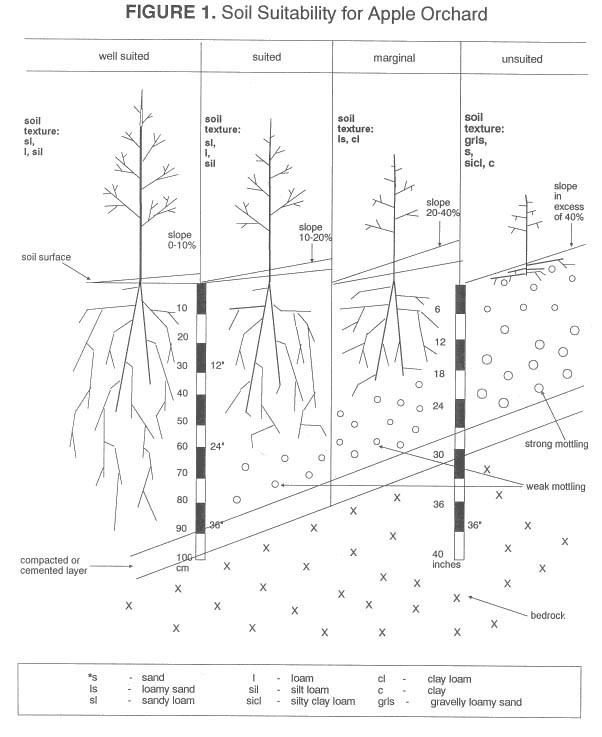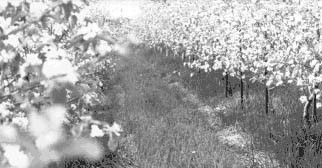
Good Orchard on suited soil.

Good Orchard on suited soil.
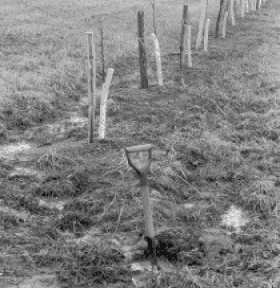
Poor Orchard on unsuited soil.
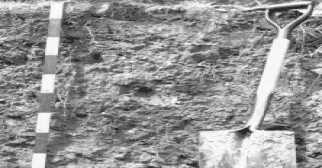
Suited Soils: well drained, deep, medium textured.
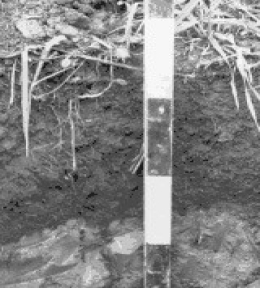
Unsuited soils: excessively wet, shallow to compacted sub soil, fine and extremely coarse textured.
The Importance of Good Site for Orchard Establishment
The overall performance of apple orchards is closely related to the soil characteristics and climate of the orchard site. The proper selection of an orchard site is the most important managerial decision the producer will make during the entire life span of the orchard. In order to realize the paramount importance of this decision, one need only take into account the high costs of land preparation, labour and materials of orchard establishment, and the long life expectancy of an orchard. The most prospering commercial apple orchards are presently located within the triangular region formed by St. Stephen, Woodstock and the Southeastern coast. This region possesses the most favourable macro-climate for apple production. However, because of microclimate and soil variability, all new proposed sites for orchard development should be evaluated before development. (The factsheet 'Reducing Cold Temperature Injury in Apples by Site Selection" should be consulted for more information).
Which and How Do Soil Characteristics Affect Apple Production?
Soil physical characteristics affect both growth and performance of apple trees by determining the soil's ability to retain moisture and nutrients, and provide an uninterrupted supply of oxygen. Also affected is the soil temperature regime, which in relation to other factors influences the occurrence and extent of winter injury and incidence of damage caused by disease and pests. Soil characteristics further affect the level of both mechanization and orchard management.
As far as supply of moisture and nutrients are concerned, a soil which allows root development to a depth of 100 cm (40 inches) is able to supply the tree with twice as much water and nutrients, as a soil of identical chemical and mechanical characteristics which limits root penetration to a depth of only 50 cm (20 inches).
Soil Limitations to Apple Production
Frequently occurring soil limitations to apple production are: impeded drainage, compacted subsoil, low water holding, capacity and excessive slope.
Impeded Drainage
Impeded drainage is the most commonly occurring soil limitation with respect to apple production. It causes water saturation within the soil profile, reduces the oxygen supply, lowers soil temperature, decreases the efficiency of applied fertilizers and increases the incidence of disease and winter injury. Surface ponding, high water table and seepage are typical cases of impeded drainage. Impeded drainage is frequently associated with other soil limitations such as compacting and fine texture (clay loam, silty clay loam and clay).
Presence of Compacted Subsoil
Compacted subsoils are another commonly occurring soil limitation to apple production, frequently found as shallow as 35 to 50 cm from the soil surface. They restrict root development and inhibit movement of water and air within the soil. Compacted subsoils frequently cause poor drainage. Trees grown where compacted subsoils are close to the soil surface also suffer from lack of moisture during prolonged dry periods.
Low Water Holding Capacity
Sandy and gravely soils have a low capacity of retaining moisture. During prolonged periods without precipitation these soils are unable to supply trees with water and nutrients needed.
Excessive Slope
Apple orchards can be established on slopes that would be considered excessive for commercial production of other crops. Slopes that exceed 20% will limit commercial apple production by restricting the applicability of mechanization.
How is Soil Suitability for Apple Orchard Determined?
The classification of soil suitability for apple orchard employs evaluation of: soil depth above consolidated or compacted layer, soil moisture regime, texture and slope.
To assure the suitability of a soil, pits 100 cm (40 inches) deep are excavated and the soil's physical characteristics determined. Table 1 illustrates the placement of proposed sites into four suitability classes as follows: well suited, suited, marginal and unsuited. If more than 80% of the inspected field is well suited or suited for apple orchards, it is recommended for apple orchard development; otherwise, major soil improvements or alternative uses of the site are recommended. The schematic diagram (Figure 1) illustrates placement into soil suitability classes according to soil profile characteristics from left (well suited) to right (unsuited) soils.
For further information contact NB the Department of Agriculture, Fisheries and Aquaculture, P.O. Box 6000, Fredericton, N.B. E3B 5H1.
Table 1. Soil Suitability for Apple Orchards |
|||||||||||||||||||||||||||||||||||||
| Soil Criteria |
Well Suited |
Suited |
Marginal |
Unsuited |
|||||||||||||||||||||||||||||||||
| Depth of soil above Consolidated bedrock |
> 100 cm |
70-100 cm |
50-70 cm |
< 50 cm |
|||||||||||||||||||||||||||||||||
| Depth of soil above compacted or cemented Layer (B.D. * > 1.6 g/cm3 |
> 90 cm |
50-90 cm |
40-50 cm |
< 40 cm |
|||||||||||||||||||||||||||||||||
| Excessive moisture (mottling) |
None |
Weak mottling Below 50 cm |
Weak mottling within 50 cm |
Strong mottling Within 50 cm |
|||||||||||||||||||||||||||||||||
| Lack of moisture |
None |
None |
Severe |
Very severe |
|||||||||||||||||||||||||||||||||
| Soil texture:** (uniform Throughout soil profile) |
sl, l, sil |
sl, l, sil |
ls, cl |
grls, s, sicl, c |
|||||||||||||||||||||||||||||||||
| Slope |
< 10% |
10-20 % |
20-40% |
> 40% |
|||||||||||||||||||||||||||||||||
|
|||||||||||||||||||||||||||||||||||||
